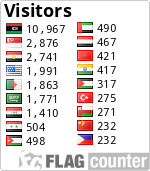Antimicrobial Activity of Cistus Plant Extracts Against Some Pathogenic Microbes Species
DOI:
https://doi.org/10.37375/foej.v2i1.551الكلمات المفتاحية:
المضاد للميكروبات، لميثانولالملخص
الهدف من الدراسة الحالية هو تقييم النشاط المضاد للميكروبات لمستخلصات أوراق الميثانول من نباتات Cistus incans L.، Cistus salvifolius L. و Cistus parviflorus Lam. ضد ستة أنواع من الميكروبات الممرضة وهي Staphylococcus aureus، Serratia marcescens ، Acinetobacter boumannii ، Aspergillus flavus، Aspergillus niger و Cladosporium cladosporioides باستخدام طريقة الانتشار بواسطة الآجار Agar well diffusion. أظهرت النتائج المتحصل عليها من المستخلصات النباتية نشاط مضاد للميكروبات جيد ضد جميع أنواع الميكروبات المختبرة. هذه المستخلصات كانت أكثر فعالية وأظهرت نشاط مثبط bacteriostatic وقاتل bactericidal ضد الأنواع الأكثر حساسية من البكتيريا الممرضة (S. aureus and S. marcescens) مع التركيز المثبط الأدنى MIC الذي بدأ من 12.5 ملغم/مل و التركيز قاتل الأدنى MBC من 25 ملغم/مل، باستثناء بكتيريا S. aureus التي كانت أكثر حساسية لمستخلص نبات C. salvifolius و سجلت 6.2 و 12.5 ملغم/مل للتركيزين على التوالي. يمكن استخدام هذه المستخلصات النباتية التي أثبتت فعاليتها كعوامل وقائية بديلة طبيعية للسيطرة على الأمراض المتسببة بواسطة هذه الأنواع الميكروبية وتجنب المخاطر الصحية من استعمال العوامل الكيميائية المضادة للميكروبات.
المراجع
• Athanassiadis, B., Abbott, P. V., George, N., & Walsh, L. J. (2009). An in vitro study of the antimicrobial activity of some endodontic medicaments and their bases using an agar well diffusion assay. Australian Dental Journal, 54(2), 141-146. https://doi.org/10.1111/j.1834- 7819.2009.01107.x
• El Karkouri, J., Bouhrim, M., Al Kamaly, O. M., Mechchate, H., Kchibale, A., Adadi, I., & Zair, T. (2021). Chemical Composition, Antibacterial and Antifungal Activity of the Essential Oil from Cistus ladanifer L. Plants, 10(10), 2068. https://doi.org/10.3390/plants10102068
• El-Mokasabi, F. (2022). Survey of Wild Trees and Shrubs in Eastern Region of Libya and Their Economical Value. AlQalam Journal of Medical and Applied Sciences, 48-55. https://doi.org/10.5281/zenodo.5838203
• Es-Safi, I., Mechchate, H., Amaghnouje, A., Elbouzidi, A., Bouhrim, M., Bencheikh, N., & Bousta, D. (2021). Assessment of antidepressant-like, anxiolytic effects and impact on memory of pimpinella anisum l. Total extract on swiss albino mice. Plants, 10(8), 1573. https://doi.org/10.3390/plants10081573
• Barrajón-Catalán, E., Fernández-Arroyo, S., Saura, D., Guillén, E., Fernández-Gutiérrez, A., Segura-Carretero, A., & Micol, V. (2010). Cistaceae aqueous extracts containing ellagitannins show antioxidant and antimicrobial capacity, and cytotoxic activity against human cancer cells. Food and Chemical Toxicology, 48(8-9), 2273-2282. http://dx.doi.org/10.1016/j.fct.2010.05.060
• Benbelaïd, F., Khadir, A., Bendahou, M., Abdoune, M. A., Muselli, A., & Costa, J. (2017). Composition and antimicrobial activity of Cistus munbyi essential oil: an endemic plant from Algeria. Journal of Forestry Research, 28(6), 1129-1134.
• Bonnier, G., Douin, R., & Poinsot, J. (1990). [La grande flore en couleurs]; La grande flore en couleurs de Gaston Bonnier: France, Suisse, Belgique et pays voisins. Belin.
• Bouamama, H., Noel, T., Villard, J., Benharref, A., & Jana, M. (2006). Antimicrobial activities of the leaf extracts of two Moroccan Cistus L. species. Journal of ethnopharmacology, 104(1-2), 104-107. https://doi.org/10.1016/j.jep.2005.08.062
• Burt, S. (2004). Essential oils: their antibacterial properties and potential application in foods: A review. International Journal of Food Microbiology, 94(3), 223–253. https://doi.org/10.1016/j. ijfoodmicro.2004.03.022
• Cheng, V. C. C., To, K. K. W., Li, I. W. S., Tang, B. S. F., Chan, J. F. W., Kwan, S., ... & Seto, W. H. (2009). Antimicrobial stewardship program directed at broad-spectrum intravenous antibiotics prescription in a tertiary hospital. European Journal of Clinical Microbiology & Infectious Diseases, 28(12), 1447-1456. https://doi.org/10.1007/s10096-009-0803-8
• Demetzos, C., Stahl, B., Anastassaki, T., Gazouli, M., Tzouvelekis, L. S., & Rallis, M. (1999). Chemical analysis and antimicrobial activity of the resin Ladano, of its essential oil and of the isolated compounds. Planta Medica, 65(01), 76-78.
• http://dx.doi.org/10.1055/s-2006-960444
• Demetzos, C., Harvala, C., Philianos, S. M., & Skaltsounis, A. L. (1990). A new labdane- type diterpene and other compounds from the leaves of Cistus incanus ssp. creticus. Journal of natural products, 53(5), 1365-1368. https://doi.org/10.1021/np50071a039
• Demetzos, C., Loukis, A., Spiliotis, V., Zoakis, N., Stratigakis, N., & Katerinopoulos, H. E. (1995). Composition and antimicrobial activity of the essential oil of Cistus creticus L. Journal of essential oil research, 7(4), 407-410. https://doi.org/10.1080/10412905.1995.9698549
• Dhivya, S., & Kalaichelvi, K. (2017). Phytochemical studies and gas chromatographymass spectrometry analysis of Sarcostemma brevistigma Wight & Arn. Asian Journal of Pharmaceutical and Clinical Research, 10(3), 462-466. http://dx.doi.org/10.22159/ajpcr.2017. v10i3.16538
• Di Pasqua, R., De Feo, V., Villani, F., & Mauriello, G. (2005). In vitro antimicrobial activity of essential oils from Mediterranean Apiaceae, Verbenaceae and Lamiaceae against foodborne pathogens and spoilage bacteria. Annals of microbiology, 55(2), 139-143.
• Gill, A. O., & Holley, R. A. (2006). Disruption of Escherichia coli, Listeria monocytogenes and Lactobacillus sakei cellular membranes by plant oil aromatics. International Journal of Food Microbiology, 108, 1–9. https://doi.org/10.1016/j.ijfoodmicro.2005.10.009
• Hegnauer, R. (1962). Chemotaxonomie der Pflanzen Eine Übersicht über die Verbreitung und die systematische Bedeutung der Pflanzenstoffe: Band 1: Thallophyten, Bryophyten, Pteridophyten und Gymnospermen. Birkhäuser Verlag Basel.
• Högberg, L. D., Heddini, A., & Cars, O. (2010). The global need for effective antibiotics: challenges and recent advances. Trends in pharmacological sciences, 31(11), 509- 515. https://doi.org/10.1016/j.tips.2010.08.002
• Karim, H., Boubaker, H., Askarne, L., Talibi, I., Msanda, F., Boudyach, E. H., & Ait Ben Aoumar, A. (2016). Antifungal properties of organic extracts of eight Cistus L. species against postharvest citrus sour rot. Letters in Applied Microbiology, 62(1), 16-22. https://doi.org/10.1111/lam.12507
• Krishnaiah, D., Sarbatly, R., & Nithyanandam, R. (2011). A review of the antioxidant potential of medicinal plant species. Food and Bioproducts Processing, 89(3), 217-233.
https://doi.org/10.1016/j.fbp.2010.04.008
• Lahcen, S. A., El Hattabi, L., Benkaddour, R., Chahboun, N., Ghanmi, M., Satrani, B., & Zarrouk, A. (2020). Chemical composition, antioxidant, antimicrobial and antifungal activity of Moroccan Cistus creticus leaves. Chemical Data Collections, 26, 100346. https://doi.org/10.1016/j.cdc.2020.100346
• Lone, B. A., Bandh, S. A., Chishti, M. Z., Bhat, F. A., Tak, H., & Nisa, H. (2013). Anthelmintic and antimicrobial activity of methanolic and aqueous extracts of Euphorbia helioscopia L. Tropical Animal Health and Production, 45(3), 743-749. https://doi.org/10.1007/s11250-012-0283-1
• Mahmoudi, H., Aouadhi, C., Kaddour, R., Gruber, M., Zargouni, H., Zaouali, W., & Hosni, K. (2016). Comparison of antioxidant and antimicrobial activities of two cultivated Cistus species from Tunisia. Bioscience Journal, 32, 226-237.
• Mariotti, J. P., Tomi, F., Casanova, J., Costa, J., & Bernardini, A. F. (1997). Composition of the essential oil of Cistus ladaniferus L. cultivated in Corsica (France). Flavour and fragrance journal, 12(3), 147-151. https://doi.org/10.1002/(SICI)1099-1026(199705)12:3<147::AID-FFJ631>3.0.CO;2-Q
• Miloud MM, Senussi NA (2021). Antibacterial activity of leaf extracts of Silene succulent Forsk. (Caryophyllaceae) against clinically important bacteria. Academia Journal of Microbiology Research, 9(1), 013-020. https://doi.org /10.15413/ajmr.2020.1101
• Miloud MM, Senussi NA (2021). Antimicrobial activity of leaf extracts of Euphorbia paralias L. and Melilotus sulcatus Desf. against some pathogenic microorganisms. Current Botany, 12, 10-15. https://doi.org/10.25081/cb.2021.v12.6643
• Mohammadi, S., Asgary, V., Shandiz, S. A. S., Heidari, E., Jozaghkar, H., Cohan, R. A., & Mirzaie, A. (2015). Antimicrobial activity of methanolic root extracts of Euphorbia condylocarpa against pathogenic bacteria. Advanced Studies in Biology, 7(2), 55-64. https://doi.org/10.12988/asb.2015.41049
• Mostafa, A. A., Al-Askar, A. A., Almaary, K. S., Dawoud, T. M., Sholkamy, E. N., & Bakri, M. M. (2018). Antimicrobial activity of some plant extracts against bacterial strains causing food poisoning diseases. Saudi Journal of Biological Sciences, 25(2), 361–366. https://doi.org/10.1016/j.sjbs.2017.02.004
• Naz, R., Ayub, H., Nawaz, S., Islam, Z. U., Yasmin, T., Bano, A., Wakeel, A., Zia, S., & Roberts, T. H. (2017). Antimicrobial activity, toxicity and anti-inflammatory potential of methanolic extracts of four ethnomedicinal plant species from Punjab, Pakistan. BMC Complementary and Alternative Medicine, 17(1), 1-13. https://doi.org/10.1186/s12906-017-1815-z
• Nikaido, H., & Vaara, M. (1985). Molecular basis of bacterial outer membrane permeability. Microbiological reviews, 49(1), 1-32 https://doi.org/10.1128/mr.49.1.1-32.1985
• Rebaya, A., Belghith, S. I., Hammrouni, S., Maaroufi, A., Ayadi, M. T., & Chérif, J. K. (2016). Antibacterial and antifungal activities of ethanol extracts of Halimium halimifolium, Cistus salviifolius and Cistus monspeliensis. International Journal of Pharmaceutical and Clinical Research, 8(4), 243-247.
• Saleem, M., Nazir, M., Ali, M. S., Hussain, H., Lee, Y. S., Riaz, N., & Jabbar, A. (2010). Antimicrobial natural products: an update on future antibiotic drug candidates. Natural product reports, 27(2), 238-254.
• Silva, N. C. C., & Fernandes Júnior, A. J. J. O. V. A. (2010). Biological properties of medicinal plants: a review of their antimicrobial activity. Journal of venomous animals and toxins including tropical diseases, 16, 402-413. https://doi.org/10.1590/S1678-91992010000300006
• Sonju, J. J., Islam, F., Sutradhar, K., & Akter, T. (2017). Analysis of phytochemical, antioxidant and microbial property of various extracts of the plant Melilotus indica. World Journal of Pharmaceutical Research, 6(4), 129-147.
https://doi.org/10.20959/wjpr20174-8050
• Surapuram, V., Setzer, W. N., McFeeters, R. L., & McFeeters, H. (2014). Antifungal activity of plant extracts against Aspergillus niger and Rhizopus stolonifer. Natural Product Communications, 9(11), 1603 – 1605. https://doi.org/10.1177/1934578X1400901118
• Teh, C. H., Nazni, W. A., Nurulhusna, A. B., Norazah, A., & Lee, H. L. (2017). Determination of antibacterial activity and minimum inhibitory concentration of larval extract of flyvia resazurin-based turbidometric assay. BMC Microbiology, 17(36), 1-8. https://doi.org/10.1186/s12866-017-0936-3
• Tomás-Menor, L., Morales-Soto, A., Barrajón-Catalán, E., Roldán-Segura, C., Segura- Carretero, A., & Micol, V. (2013). Correlation between the antibacterial activity and the composition of extracts derived from various Spanish Cistus species. Food and Chemical Toxicology, 55, 313-322. http://dx.doi.org/10.1016/j.fct.2013.01.006
• Valgas, C., Souza, S. M. D., Smânia, E. F., & Smânia, Jr. A. (2007). Screening methods to determine antibacterial activity of natural products. Brazilian Journal of Microbiology 38(2), 369-380. http://dx.doi.org/10.1590/S1517-83822007000200034
• Zohary, M. (1987): Flora Palaestina. Jerusalem Academic Press, 2, 336–337.
• Vogt, T., Proksch, P., & Gültz, P.G. (1987). Epicuticular flavonoids in the genus Cistus, Cistaceae. J Plant Phy siol, 131, 25-36. https://doi.org/10.1016/s0176-1617(87)80264-x











